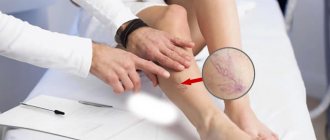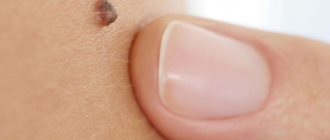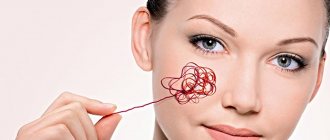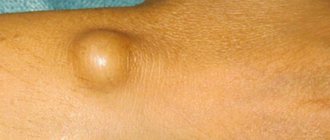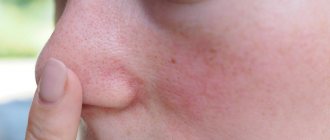The expansion of intradermal capillaries is not only an aesthetic defect, it is a serious “bell” that your vascular system of the lower extremities has problems. They may be associated with hereditary disorders of blood circulation and fragility of the walls of blood vessels. Secondary signs may include age, excess weight, pregnancy and other risk factors. You cannot make a diagnosis yourself; at the first appearance of a “pattern,” you should immediately consult a phlebologist for timely treatment.
What is microsclerotherapy (removal) of telangiectasia (spider veins)?
Microsclerotherapy of telangiectasia (spider veins) is a modern cosmetic procedure aimed at removing small-diameter venous vessels by introducing substances (sclerosants) specially developed for this purpose into their lumen. The technique is based on the effect of a chemical burn of the inner wall of the asterisk with subsequent fibrosis of the vessel.
Microsclerotherapy procedure for telangiectasis
The microsclerotherapy procedure for telangiectasia is the “gold standard” for the removal of these vascular formations that arise from persistent dilatation of the smallest veins. This state of affairs is associated with a high aesthetic effect, safety and good tolerability of microsclerotherapy for telangiectasia.
Prevention of spider veins
To avoid the appearance of spider veins, you must:
- lead a healthy lifestyle;
- Healthy food;
- competently and promptly treat vein diseases;
- take hormonal medications only as prescribed by a doctor;
- wash with cool water;
- refuse to take a hot shower or bath;
- Wear comfortable shoes to reduce the stress on your feet.
If small spider veins do appear, to prevent their spread throughout the body, it is recommended:
- do not massage their localization sites;
- use tonics and lotions (not soap) to wash your face;
- do not wash with hot water;
- do not actively cleanse your face;
- do not use hormonal creams;
- do not use paraffin masks;
- do not do vacuum massage;
- Avoid hot wax during cosmetic procedures.
This article is posted for educational purposes only and does not constitute scientific material or professional medical advice.
What is telangiectasia (spider veins)
Telangiectasia (spider veins) is a persistent dilation of the smallest vessels of the skin: venules, arterioles and capillaries. The dilations of the smallest arteries rarely exceed a diameter of 0.2 mm and are predominantly red in color. These are red telangiectasia. To remove them, methods based on physical influence are used: radiofrequency and laser percutaneous exposure.
Types of spider veins
The clinical significance of telangiectasia is still discussed by leading European phlebologists. However, the contribution of telangiectasia to the development of symptoms of chronic venous insufficiency is rather exaggerated. The leading clinical significance of telangiectasia is a pronounced cosmetic defect. The so-called “blue” telangiectasias are dilated venules. It is these formations that are the leading reason for turning to an aesthetic phlebologist.
Symptoms
Dilated capillaries can be found throughout the body - on the face, arms, legs. According to external signs, vascular dilations are divided into:
- linear
- point
- arachnids
- tree-like
The linear appearance of the stars is usually located on the wings of the nose and cheeks. Pathology is a cosmetic disease called “culerosis”.
Point vascular branches develop with varicose veins of the extremities. The affected areas are sore and intensely discolored.
Arachnid and dendritic vascular changes include numerous enlarged capillaries. They have a red tint and diverge in different directions. They are localized in all parts of the human body.
What is the method of microsclerotherapy for telangiectasia (spider veins) based on?
The microsclerotherapy technique is based on the chemical effect of special substances (sclerosants) on the inner wall of the vessel, followed by its exclusion from the bloodstream and resorption.
Spider vein removal procedure
A very important point in this process is the absence of damaging effects on healthy venous vessels. This happens because in a normally functioning vein there is a fairly high blood flow rate and the sclerosant is quickly diluted to a concentration that does not have a damaging effect.
Diagnosis of the disease
“If you are experiencing similar symptoms, we advise you to make an appointment with your doctor.
You can also make an appointment by phone: +7 (499) 214-00-00 Doppler ultrasound is performed to assess the state of blood flow. Diagnostics allows you to obtain the necessary information about blood circulation in peripheral vessels, find out the speed of blood flow, and detect existing disorders.
Additional diagnostic measures include a functional examination of the genital organs, liver, and heart. After performing the necessary studies, the doctor assesses the nature of the pathology.
A good modern sclerosant, as it should be
A good modern sclerosant should have the following properties:
- The substance must not be toxic to the human body
- The sclerosing effect should be caused only by a strictly defined concentration of the drug, subject to prolonged contact with the vein wall
- No allergic reactions to sclerosant
- The drug must have the necessary strength to obliterate sufficiently large vessels, and be safe in case of extravasation (going beyond the boundaries of the vessel)
- The drug should not cause scarring or skin pigmentation effects
- No pain effect on drug administration
- The sclerosant must have good solubility in physiological solution.
Types of modern sclerosants
All modern sclerosants can belong to one of the following groups:
- Detergent preparations. The chemical structure of these substances is based on fatty acids or alcohols. The mechanism of their action is based on the extraction of protein molecules from the surface membrane of the endothelial cell of venous vessels, the cell is irreversibly damaged and dies. This effect works only in the range of a certain sclerosant concentration, below which there is no effect on vascular cells. This group is represented by the following drugs:
- Ethoxysclerol (Polidocanol).
- Sodium tetradecyl sulfate (fiberwein).
Everything is ready for microsclerotherapy
In addition to these drugs, the following detergents are also used in the world: sodium morruate, ethanolamine oleate, glycerin.
- Cell toxin preparations are used by some specialists for sclerosis of vascular formations.
- Hypertonic and ionic solutions. Modern European phlebologists also use the following sclerosants of this group:
- Hypertonic sodium chloride solution (20 and 23.4% solutions).
- Sclerodex (a combination of a solution of 25% glucose and 10% sodium chloride).
- Ionized iodine preparations (variglobin, sclerodin).
- 75% glucose solution.
In Russia today only drugs from the detergent group are approved for use: polidocanol (ethoxysclerol) and tetradecyl sulfate (fiberwein). The issue of admitting 75% glucose solution into medical phlebological practice is being actively resolved.
Microsclerotherapy techniques used in the Moscow City
At the Moscow City Phlebology Center we use only the most modern types of microsclerotherapy (scleroobliteration of veins).
Sclerosants for microsclerotherapy
- Telangiectasia (spider veins), diameter up to 1 mm, are removed using a liquid form of the drug: polidocanol (0.25 - 0.75%), tetradecyl sulfate (0.1 - 0.2%).
- To remove venulectasias (diameter 1-2 mm) and reticular veins (2-4 mm), both microsclerotherapy solution and microfoam sclerotherapy (foam-form) are used. Concentration of active substance: polidocanol - 0.5-1%, sodium tetradecyl sulfate - 0.25-0.4%.
Treatment of the disease
The following methods of treating spider veins are used at GMS Hospital:
- sclerotherapy;
- photocoagulation (laser removal);
- VenaSeal – sealing of veins using biological cyanoacrylate glue;
- microphlebectomy.
Sclerotherapy is one of the most effective and safe methods of treating small capillaries and veins, mainly aimed at eliminating cosmetic defects. The essence of this procedure is that by injecting a special sclerotherapy into the lumen of the vein, it damages the inner lining of the venous vessel. Because of this, the capillary begins to collapse, its walls stick together and are further filled with connective tissue. Depending on the size and shape of the spider vein, several procedures may be necessary to obtain the ideal cosmetic result. The procedure can be performed not only on the veins of the lower extremities, but also in other locations.
Depending on the size of the vein, methods may be used:
- microsclerotherapy;
- foam sclerotherapy (Foam form);
- echosclerotherapy (under ultrasound guidance).
After the procedure, it is necessary to wear compression stockings.
Photocoagulation is based on percutaneous irradiation of spider veins with a special laser, the energy of which heats the veins, which leads to their welding and closing of the lumen. The method allows you to quickly eliminate veins of various sizes and locations, both on the legs and on the face and body.
VenaSeal - adhesive vein obliteration is aimed at eliminating a larger venous network by introducing a special biological glue into the vein, which instantly glues the vein together, leading to its visual disappearance. After the procedure, it is necessary to wear compression stockings.
Microphlebectomy is a technique for eliminating the subcutaneous venous network. In this case, under local anesthesia, the dilated vein is completely removed through micropunctures, which eliminates the possibility of its reoccurrence. Does not require hospitalization.
You have questions? We will be happy to answer any questions Coordinator Tatyana
Indications for spider vein removal in Moscow
The microsclerotherapy procedure in the presence of telangiectatic disease and reticular varicose veins in leading European clinics is carried out for cosmetic reasons. Often, when a large number of small vessels are removed, patients note an improvement not only in self-esteem, but also in sensations in the leg area. This is due to the elimination of the pathological venous bed and the elimination of symptoms of venous stagnation. Good phlebological practice involves diagnosing the venous system before starting microsclerotherapy procedures. Often, dilation of the smallest vessels is associated with disruption of the valve apparatus of the main saphenous veins, even without the formation of visible varicose veins. According to the standards of European phlebology clinics, such diagnostics are carried out for all patients, even if the complaints consist only of the presence of telangiectasis.
VASPIRAS AND THE REASONS FOR THEIR APPEARANCE
Telangiectasias (spider veins) are the result of dilation of superficial intradermal capillaries. In cases of a long-term defect, the structure of the capillary walls may be disrupted, their compaction and loss of elasticity may occur. Dilated capillaries are clearly outlined and appear under the skin as bluish or red structures in the form of small lines, a fine network - “cobwebs” or multiple dots.
The appearance of telangiectasia - spider veins - can be associated with two main reasons:
- As a result of congenital diseases that are accompanied by dilation of superficial skin capillaries (xeroderma pigmentosum, mastocytosis, Raynaud's disease, connective tissue dysplasia, etc.);
- It is provoked by the following factors - hormonal imbalance (for example, a high concentration of estrogen in the blood during pregnancy), frequent and prolonged exposure to sunlight and radiation, acquired diseases of various organs and systems, a sedentary lifestyle, alcohol abuse and smoking, etc.
The presence of spider veins in itself is not regarded by doctors as a pathological human condition, but is only a cosmetic defect. According to statistics, currently more than 30% of adult men and more than 50% of women over 35 years of age have this cosmetic problem.
Contraindications to microsclerotherapy
The microsclerotherapy procedure for telangiectasia is an innovative, fairly safe, planned procedure. But, as with absolutely any invasive technique, it has contraindications:
- Skin diseases in the area of intervention of an inflammatory and infectious nature.
- Acute period of deep or superficial vein thrombosis.
- Pregnancy and lactation period.
- Allergic reaction to sclerosant.
- Presence of thrombophilia (hypercoagulable state).
- Impaired motor activity of the patient.
- The presence of an open oval window of the heart (for the use of a foam form of the drug).
- Lymphostasis.
Adequate compression after the procedure significantly improves the aesthetic result. Therefore, aesthetic microsclerotherapy in patients for whom compression therapy is contraindicated is not contraindicated, but has its own nuances.
In the presence of morbid obesity, as a rule, a larger number of microsclerotherapy sessions are required and difficulties in selecting compression stockings are required. During long flights and hormonal therapy, it is better to refrain from aesthetic procedures and perform it later.
Causes of the disease
Among all the factors in the manifestation of vascular changes, the main group of causes has been identified:
- chronic vascular diseases – varicose veins, rosacea, inflammation of the veins (phlebitis);
- hormonal disorders - pregnancy, childbirth, abortion, menopause, fibroids, ovarian cysts;
- long-term hormone replacement therapy;
- burdened hereditary history (passed on to children from parents);
- hard physical work, standing for a long time, wearing high-heeled shoes (salespeople, factory workers, hairdressers, models);
- obesity degree II and III;
- too frequent visits to the sauna, steam bath or other SPA treatments;
- chronic alcoholism;
- lack of vitamin C, E, K, P, midi, silicon;
- age over 40 years (when blood vessels lose their tone);
- liver diseases.
How is the microsclerotherapy procedure performed in a modern phlebological center in Moscow?
In our phlebological center, we use some of the best thinnest needles with laser sharpening of 27-30 G. Using these tools, skin punctures are made that are practically not felt by patients. The procedure is performed by an experienced phlebologist, who has not only thousands of procedures under his belt, but also a significant number of master classes on this technology.
Master class performed by phlebologist Semenov A.Yu. on microsclerotherapy
Sessions are carried out with the patient in a horizontal position. After puncturing the skin, the tip of the needle enters the vessel, the specialist slowly and carefully injects the drug, making sure that the vein does not overstretch and rupture.
After the session, sterile bandages are applied and compression stockings are put on. The patient is recommended to take a half-hour walk.
Complications and side effects after a microsclerotherapy session
Minor ecchymosis (bruising) at the injection sites after the procedure is almost all that worries patients. These phenomena disappear within 1-2 weeks. Complications and side effects of sclerotherapy are quite rare, but you still need to know about them:
- Skin hyperpigmentation is a fairly rare phenomenon and goes away on its own within 6-12 months.
- Local tissue swelling. It resolves on its own and does not require separate treatment.
- Neurological complications: migraine-like headache, temporary impairment of visual fields, extremely rare complications that arise when working with the foam form of sclerosant in patients with congenital heart disease (patent foramen ovale). These phenomena disappear on their own within 10-15 minutes.
- Metting is the appearance of the finest red telangiectasia in the injection area. These manifestations disappear within a few months.
- Skin necrosis occurs when sclerosant enters the perivascular tissue in high concentrations. This is a very rare occurrence and is most often associated with improper manipulation technique.
- Allergic reactions to the drug. Modern sclerosants rarely cause sensitization of the body, but you should always remember this phenomenon.
First signs and main symptoms
To avoid lengthy and complex treatment, it is important to identify the disease in the early stages. It makes no sense to say that only a specialist can do this, this is obvious. The patient’s main task is to distinguish the earliest symptoms in order to see a doctor before spider veins appear. The first signs include:
- itching, burning, regular pain in the legs after a long walk, swelling;
- the red-violet mesh is still absent at this stage, but by the end of the day muscle fatigue usually appears, the patient feels nervous tension due to severe pain inside the lower leg.
People with chronic diseases or family history should pay special attention to their body. The disease progresses at different rates, depending on the individual characteristics of the body and the presence of harmful factors. If it is not possible to avoid the appearance of capillaries, then timely treatment of spider veins is required. The main symptoms of telangiectasia are:
- red-violet dots appear on areas of the skin, which gradually turn into stripes;
- most often, the stripes spread quickly, intersecting each other, forming a pattern similar to a web;
- after a long walk, the legs quickly swell and get tired, swelling is observed in the shins;
- spider veins quickly progress, spread to new areas of the body, and the first signs of varicose veins appear;
- at a late stage of the disease, the patient experiences night cramps, a general deterioration in condition, incl. skin, bruising may occur due to cracked capillaries.
Patients should pay attention to the general condition of the body. Due to impaired blood circulation, a person experiences headaches and increased body temperature.
Cosmetic microsclerotherapy (microscleroobliteration) at the Moscow Phlebology Center
The microsclerotherapy method is deservedly called the “gold standard” for the removal of telangiectasia. Due to its minimal invasiveness, good patient tolerance and good clinical effect, the microsclerotherapy technique has taken its rightful place in modern phlebological practice. Cosmetic microsclerotherapy at the Moscow City Phlebological Center is performed by some of the best phlebologists in Moscow and Russia according to the most modern European standards.
Microsclerotherapy performed by phlebologist of the MIFC Raskin V.V.
We use the most advanced technologies to achieve not only a good clinical effect, but also the best aesthetic result.
Microclerotherapy (removal) of stars in Moscow - price for procedures
At our center in Moscow, the price for the microsclerotherapy procedure is strictly fixed, and therefore, when contacting our clinic, patients can count on high-quality service, treatment and an affordable cost. And remember that timely consultation with a doctor will completely cure the disease and avoid its recurrence.
| Service | Treatment category | Price |
| Sclerotherapy (microsclerotherapy) on one lower limb (one session) | Reticular varicose veins and spider veins | 8000₽ |
| Postoperative sclerotherapy (microsclerotherapy) on one lower limb (one session) | Reticular varicose veins and spider veins | 4000₽ 8000₽ |
| Sclerotherapy (microsclerotherapy) on one lower limb (course of treatment) | Does not depend on the number of sessions | 35000₽ |
| Removal of unaesthetic veins on one arm (one session) | 10000₽ | |
| Laser removal of spider veins on one lower limb (one session) | 10000₽ |
For the convenience of our patients, we work with banks that offer credit lines. Also in our center there is a flexible system of discounts and installments. Payment by Visa and Mastercard is possible. At the end of the course of treatment, the patient is given a package of documents to submit to the tax office for tax deduction.
Why you need to act immediately
Telangiectasia may be the first symptom of a serious vascular disease, the onset of an oncological process, or simply occur as a result of increased physical work or failure to maintain a healthy lifestyle. Therefore, you should not put off going to the doctor. It is necessary to conduct a timely examination by specialists, do examinations, differentiate the disease and make a diagnosis.
If you do not pay attention to spider veins, you can miss the occurrence of more serious diseases of the venous system and aggravate their course. After which it will no longer be possible to correct the situation using microsurgical technologies.
It is also worth noting that self-medication, warming and applying bandages with folk remedies is not worth it, as this can enlarge the area of spider veins, change their shape and increase their number.
Results of microsclerotherapy for telangiectasis. Photos before and after spider vein removal
The result of treating a patient at the MIFC phlebology clinic using microsclerotherapy (removal) of spider veins
Photos before and after removal of spider veins on the left thigh
Result of spider vein removal on the right lower limb
Result of spider vein removal 1 month after microsclerotherapy
Video result of spider vein removal in our patient on both lower extremities
Diagnosis of the disease
Diagnosis of the disease at the center for non-invasive surgery and phlebology GMS Clinic includes:
- examination by a doctor - vascular surgeon, phlebologist;
- detailed analysis of anamnestic data of life and illness;
- performing ultrasound of blood vessels;
- consultation with a highly specialized specialist - cardiologist, endocrinologist, gynecologist (if necessary);
- additional diagnostic methods - laboratory blood tests.
After a comprehensive examination, the doctor confirms the diagnosis and prescribes the necessary treatment.
Questions from patients about the procedure of microsclerotherapy (removal) of spider veins
How much does modern microsclerotherapy for spider veins cost in Moscow?
A session of modern microsclerotherapy for spider veins in our Moscow city center costs 8 thousand rubles. You can find out more detailed information about the cost of treatment by phone or on our website page:.
Where is the best place to do microsclerotherapy for spider veins in Moscow?
Microsclerotherapy of spider veins in Moscow is best performed in a good city phlebology center, where they work according to modern European standards.
Is microsclerotherapy for telangiectasia and reticular veins performed simultaneously in Moscow?
Simultaneous microsclerotherapy sessions for telangiectasia and reticular veins are performed in the best Moscow clinics. This is a good procedure for quickly eliminating unsightly venous vessels.
Where can I read reviews about microsclerotherapy for spider veins and reticular veins?
Reviews from patients about microsclerotherapy for spider veins and reticular veins at the city phlebological center can be read on our website page: .
More about the disease
Vascular network (asterisk) is a small intradermal expansion of all types of vessels that lose their tone.
They can appear both on the skin of the face (the wings of the nose, cheeks) and on other parts of the body - legs, abdomen, thighs. This pathological process is persistent. If you once notice spider veins on your body, they will not disappear on their own.
Therefore, such manifestations cannot be ignored; it is necessary to seek medical help from a specialist.
You can make an appointment with a doctor at the GMS Hospital center at any time convenient for you. This can be done by calling a contact phone number or through the online system on our website.

